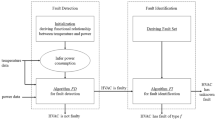Abstract
Studies have shown that heating ventilation and air-conditioning (HVAC) systems are the major contributors to the high energy consumption of buildings. This has some serious deleterious effects on the environment. Thus, to reduce and optimize the energy consumption, it is important for the HVACs to work efficiently at all times. Existing techniques have focused on the optimal usage of HVACs for minimizing the energy consumption of buildings. This paper offers a pragmatic and holistic solution for saving energy in smart buildings by detecting faulty HVACs using power consumption and temperature data only. The developed approach is applied to a building consisting of forty-eight HVACs and is situated in Mumbai. A total of thirty-one HVACs were detected to be faulty. The results indicate that about 46% of energy can be saved if all the HVACs operating in the building are free of faults. This is an impressive saving in energy consumption, which demonstrates the effectiveness of this novel approach.







Similar content being viewed by others
References
Demand Analysis for Cooling by Sector in India in 2027. https://aeee.in/demand-analysis-of-cooling-by-sector-in-india-in-2017-and-2027-2/
International Energy Agency. India 2020 Energy Policy Review. https://webstore.iea.org/download/direct/2933?fileName=India_2020-Policy_Energy_Review.pdf , 2020.
F. Al-Turjman, C. Altrjman, S. Din, A. Paul, Energy monitoring in IoT-based ad hoc networks: an overview. Comput. Electr. Eng. 76, 133–142 (2019)
K. Mason, S. Grijalva, A review of reinforcement learning for autonomous building energy management. Comput. Electr. Eng. 78, 300–312 (2019)
L. Perez-Lombard, J. Ortiz, C. Pout, A review on buildings energy consumption information. Energy Build. 40(3), 394–398 (2008)
T. Downey, J. Proctor, What can 13,000 air conditioners tell us, in Proceedings of the 2002 ACEEE Summer Study on Energy Efficiency in Buildings, vol. 1, pp. 53–67, 2002.
A. Agarwal, V. Munigala, K. Ramamritham, Observability: a principled approach to provisioning sensors in buildings, in Proceedings of the 3rd ACM International Conference on Systems for Energy-Efficient Built Environments (BuildSys ’16), ACM, New York, USA, pp. 197–206, 2016.
A. Agarwal, V. Munigala, K. Ramamritham, Observability: replacing sensors with inference engines, in Proceedings of the Seventh International Conference on Future Energy Systems Poster Sessions (e-Energy ’16), ACM, New York, USA, pp. 1–2, 2016
A. Beghi, R. Brignoli, L. Cecchinato, G. Menegazzo, M. Rampazzo, F. Simmini, Data-driven fault detection and diagnosis for HVAC water chillers. Control. Eng. Pract. 53, 79–91 (2016)
D. Gao, S. Wang, K. Shan, C. Yan, A system-level fault detection and diagnosis method for low delta-T syndrome in the complex HVAC systems. Appl. Energy 164, 1028–1038 (2016)
S. Katipamula, M.R. Brambley, Review article: methods for fault detection, diagnostics, and prognostics for building systems a review, part I. HVAC&R Research 11(1), 3–25 (2005)
P.M. Frank, Fault diagnosis in dynamic systems using analytical and knowledge-based redundancy: a survey and some new results. Automatica 26(3), 459–474 (1990)
R. Isermann, Process fault detection based on modeling and estimation methods A survey. Automatica 20(4), 387–404 (1984)
S. Li, J. Wen, A model-based fault detection and diagnostic methodology based on PCA method and wavelet transform. Energy Build. 68, 63–71 (2014)
G. Karmakar, U. Arote, A. Agarwal, K. Ramamritham, Adaptive hybrid approaches to thermal modeling of building, in Proceedings of the Ninth International Conference on Future Energy Systems (e-Energy ’18), ACM, New York, USA, pp. 477–479, 2018
M. Bonvini, M.D. Sohn, J. Granderson, M. Wetter, M. Ann Piette, Robust on-line fault detection diagnosis for HVAC components based on nonlinear state estimation techniques. Appl. Energy 124, 156–166 (2014)
D. Dey, B. Dong, A probabilistic approach to diagnose faults of air handling units in buildings. Energy Build. 130, 177–187 (2016)
M. Najafi, D.M. Auslander, P.L. Bartlett, P. Haves, M.D. Sohn, Application of machine learning in the fault diagnostics of air handling units. Appl. Energy 96, 347–358 (2012)
S.M. Namburu, M.S. Azam, J. Luo, K. Choi, K.R. Pattipati, Data-driven modeling, fault diagnosis and optimal sensor selection for HVAC chillers. IEEE Trans. Autom. Sci. Eng. 4(3), 469–473 (2007)
H. Shahnazari, P. Mhaskar, J.M. House, T.I. Salsbury, Modeling and fault diagnosis design for HVAC systems using recurrent neural networks. Comput. Chem. Eng. 126, 189–203 (2019)
H. Teimourzadeh, F. Jabari, B. Mohammadi-Ivatloo, An augmented group search optimization algorithm for optimal cooling-load dispatch in multi-chiller plants. Comput. Electr. Eng. 85, 106 (2020)
W.J.N. Turner, A. Staino, B. Basu, Residential HVAC fault detection using a system identification approach. Energy Build. 151, 1–17 (2017)
Y. Yu, D. Woradechjumroen, D. Yu, A review of fault detection and diagnosis methodologies on air-handling units. Energy and Build. 82, 550–562 (2014)
Y. Zhao, S. Wang, F. Xiao, Pattern recognition-based chillers fault detection method using Support Vector Data Description (SVDD). Appl. Energy 112, 1041–1048 (2013)
V. Martinez-Viol, E. M. Urbano, K. Kampouropoulos, M. Delgado-Prieto, L. Romeral, Support vector machine based novelty detection and FDD framework applied to building AHU systems, in Proceedings of the 25th IEEE International Conference on Emerging Technologies and Factory Automation (ETFA), Vienna, Austria, 2020, pp. 1749–1754, 2020
S. Gharsellaoui, M. Mansouri, M. Trabelsi, M.F. Harkat, S.S. Refaat, H. Messaoud, Interval-valued features based machine learning technique for fault detection and diagnosis of uncertain HVAC systems. IEEE Access 8, 171892–171902 (2020)
C.P. Dowling, B. Zhang, Transfer learning for HVAC system fault detection, in Proceedings of the American Control Conference (ACC), Denver, CO, USA, pp. 3879–3885, 2020
Schneider Electric Smartmeter EM6400. https://www.schneider-electric.co.in/library/SCHNEIDER_ELECTRIC/SE_LOCAL/APS/203086_FC3E/EM_6400_Manual Firmware_03.02.xx_.pdf
DS18B20 Digital Thermometer. https://datasheets.maximintegrated.com/en/ds/DS18B20.pdf
Funding
Not Applicable.
Author information
Authors and Affiliations
Corresponding author
Ethics declarations
Conflict of interest
The author declares that there is no conflict of interest.
Additional information
Publisher's Note
Springer Nature remains neutral with regard to jurisdictional claims in published maps and institutional affiliations.
Rights and permissions
About this article
Cite this article
Agarwal, A. A Novel Approach to Save Energy by Detecting Faulty HVACs. J. Inst. Eng. India Ser. B 103, 305–311 (2022). https://doi.org/10.1007/s40031-021-00666-7
Received:
Accepted:
Published:
Issue Date:
DOI: https://doi.org/10.1007/s40031-021-00666-7




